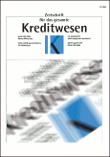Sie befinden sich hier: Home › Kreditwesen › Ergänzende Informationen › Archivdaten › Developments in the US Pension Marketplace
Archivdaten
15.10.2007
Aufsätze
Developments in the US Pension Marketplace

Dieser Artikel ist Teil unseres Online-Abo Angebots.